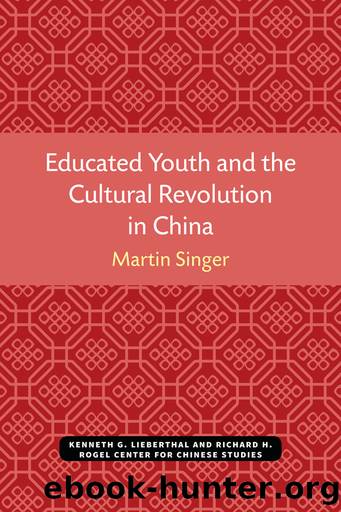Educated Youth and The Cultural Revolution in China by Martin Singer

Author:Martin Singer
Language: eng
Format: epub
Publisher: Kenneth G. Lieberthal and Richard H. Rogel Center for Chinese Studies
Published: 2020-01-15T00:00:00+00:00
Attempts to Resume Classes: IV
The next campaign to resume classes was officially promulgated on October 14 in a CCPCC Circular. First, all universities, secondary schools and primary schools without exception were ordered to commence classes immediately. Second, Maoâs directive concerning combating self-interest and repudiating revisionism was to be seriously enacted. Third, teaching, study and reforms were all to be carried out simultaneously. Fourth, all schools were to realize the revolutionary great alliance and establish the leadership of three-in-one combinations. Fifth, teachers for the most part were to be considered good or comparatively good; those teachers who had made mistakes but had recognized and corrected them, were to be allowed to continue work. Sixth, preparations were to be made immediately for the recruitment of new students.209
During October, editorials supporting these provisions and reporting the progress of various universities and middle schools appeared. 209a Tung Châi Universityâs educational reforms received attention on October 30 when it was reported that the students had visited factories and villages to solicit the opinions of workers and peasants on transforming education.210 On November 3 JMJP featured the tentative proposals of Tung Châi University for transforming education. The emphasis was to be on combining education and production. The school was to be administered by two three-way alliances. The first would combine revolutionary leading cadres, leaders of revolutionary mass organizations and the militia while the other would include teaching, designing and building units. Students were to engage in productive labor each year with the necessary term of study reduced to three years. This new system was supposed to be conducive to the ideological remoding of intellectuals and the elimination of town/country, worker/peasant and mental labor/manual labor dichotomies.211
The reform program of Peking Teachersâ University dealt more specifically with academic matters. Examinations were to be used to promote study by testing reasoning instead of mere memory. Students would no longer repeat courses. Politics was to be stressed and student initiative was to be cultivated. The class line was to be carried out in admitting new students with entrance examinations abolished in favor of the system of recommendation and selection.212
One of the most interesting documents of the period concerning teacher/student relationships, âStipulating Respect for Teachers and Love for Studentsâ, formulated by a Peking Middle School, was reproduced by NONA on November 11. The main. emphasis for students was on developing greater self-discipline and a relationship of political concern for and mutual help with the teachers. Teachers were to creatively apply Maoâs thought, maintain âtogetherness with the students,â maintain self-discipline and have respect for the opinion of the masses.213
The theme that resistance to revolutionary struggle arose from concern with âselfâ was developed further in an article by East China Teachers University which prescribed five points necessary for a successful educational revolution: the study of Maoâs thought; the practice of struggle and criticism before transformation; the transformation of the educational system as a whole, rather than specific subjects; the fostering of a new relationship of unity and helpfulness between teachers and students and the furtherance of revolution within the university, rather than outside it.
Download
This site does not store any files on its server. We only index and link to content provided by other sites. Please contact the content providers to delete copyright contents if any and email us, we'll remove relevant links or contents immediately.
| Africa | Americas |
| Arctic & Antarctica | Asia |
| Australia & Oceania | Europe |
| Middle East | Russia |
| United States | World |
| Ancient Civilizations | Military |
| Historical Study & Educational Resources |
The Third Pole by Mark Synnott(687)
Money for Nothing by Thomas Levenson(633)
The Economist (20210109) by calibre(582)
Christian Ethics by Wilkens Steve;(578)
Made in China by Anna Qu(553)
100 Posters That Changed The World by Salter Colin T.;(505)
Reopening Muslim Minds by Mustafa Akyol(494)
The Irish Buddhist by Alicia Turner(489)
Routledge Handbook of Contemporary India by Knut A. Jacobsen(484)
Nonstate Warfare by Stephen Biddle(475)
Culture by Terry Eagleton(466)
The Age of Louis XIV: The Story of Civilization by Will Durant(464)
The Great Pyramid Void Enigma by Scott Creighton(459)
Ideology by Eagleton Terry;(447)
The Shortest History of China by Linda Jaivin(442)
Banaras: CITY OF LIGHT by Diana L. Eck(433)
Objects of Vision by Saab A. Joan;(433)
The Jews of Silence: A Personal Report on Soviet Jewry by Elie Wiesel(431)
Sybille Bedford by Selina Hastings(419)
